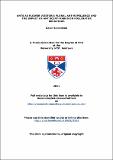Files in this item
Ants as flower visitors : floral ant-repellence and the impact of ant scent-marks on pollinator behaviour
Item metadata
| dc.contributor.advisor | Willmer, Pat | |
| dc.contributor.author | Ballantyne, Gavin | |
| dc.coverage.spatial | vi, 170 | en_US |
| dc.date.accessioned | 2012-04-03T15:21:06Z | |
| dc.date.available | 2012-04-03T15:21:06Z | |
| dc.date.issued | 2011-11 | |
| dc.identifier | uk.bl.ethos.552674 | |
| dc.identifier.uri | https://hdl.handle.net/10023/2535 | |
| dc.description.abstract | As flower visitors, ants rarely benefit a plant, commonly disrupting pollination by deterring other flower visitors, or stealing nectar. This thesis examines three aspects of ant-flower interactions, focusing on the occurrence of floral traits that prevent disruption of pollination and a novel means by which ants may influence pollinator behaviour. To assess which types of plant species possess ant-repelling floral traits I carried out a survey of 49 Neotropical plant species. Around a third of these species were repellent to the common generalist ant Camponotus novograndensis (Formicinae). This repellence was positively correlated with large nectar volumes within individual flowers. It appears that there has been selection for floral ant-repellence as a defence against ant thieves in plant species that invest in large volumes of nectar. In some cases these repellent traits were effective against a wide range of ant species. However, in no plant species were predacious ants particularly repelled, indicating that there may be little selective pressure on non-ant-plants to defend potential pollinators from aggressive ants. To investigate the importance of coevolution in determining the effectiveness of ant-repellents, a small but diverse range of Mediterranean plant species were tested with the invasive nectar thieving ant Linepithema humile (Dolichoderinae) and the native but non-nectar thieving ant Messor bouvieri (Myrmecinae). Responses of both ant species to floral traits were very similar. The ability of some plants to restrict access to ant species with which they have no evolutionary history may help to reduce the impact invasive species, as nectar thieves, have on plant-pollinator interactions. It is reported that flowers recently visited by bees and hoverflies may be rejected for a period of time by subsequent bee visitors through the detection of scent-marks. Nectar-thieving ants could potentially influence the foraging decisions of bees in a similar way if they come to associate ant trail pheromones or footprint hydrocarbons with poor reward levels. However, my empirical work found no differences were found in bee visitation behaviour between flowers of Digitalis pupurea (Plantaginaceae), Bupleurum fruticosum (Apiaceae) or Brassica juncea (Brassicaceae) that had been in contact with ants and control flowers. Ant-attendance at flowers of these species may not reduce reward levels sufficiently to make it worthwhile for bees to incorporate ant scent-marks into foraging decisions. Investigations like these into the interactions between ants, flowers and other flower visitors are essential if we hope to understand the part ants play in pollination ecology, and determine how ants have helped shape floral evolution. | en_US |
| dc.language.iso | en | en_US |
| dc.publisher | University of St Andrews | |
| dc.subject.lcc | QK926.B26 | |
| dc.subject.lcsh | Insect-plant relationships | en_US |
| dc.subject.lcsh | Ants--Behavior | en_US |
| dc.subject.lcsh | Insect pollinators--Behavior | en_US |
| dc.subject.lcsh | Flowers--Evolution | en_US |
| dc.title | Ants as flower visitors : floral ant-repellence and the impact of ant scent-marks on pollinator behaviour | en_US |
| dc.type | Thesis | en_US |
| dc.type.qualificationlevel | Doctoral | en_US |
| dc.type.qualificationname | PhD Doctor of Philosophy | en_US |
| dc.publisher.institution | The University of St Andrews | en_US |
This item appears in the following Collection(s)
Items in the St Andrews Research Repository are protected by copyright, with all rights reserved, unless otherwise indicated.

